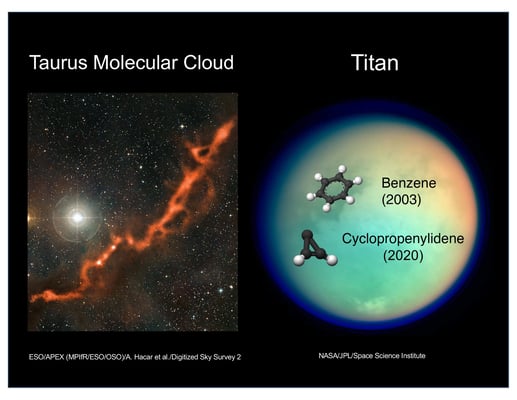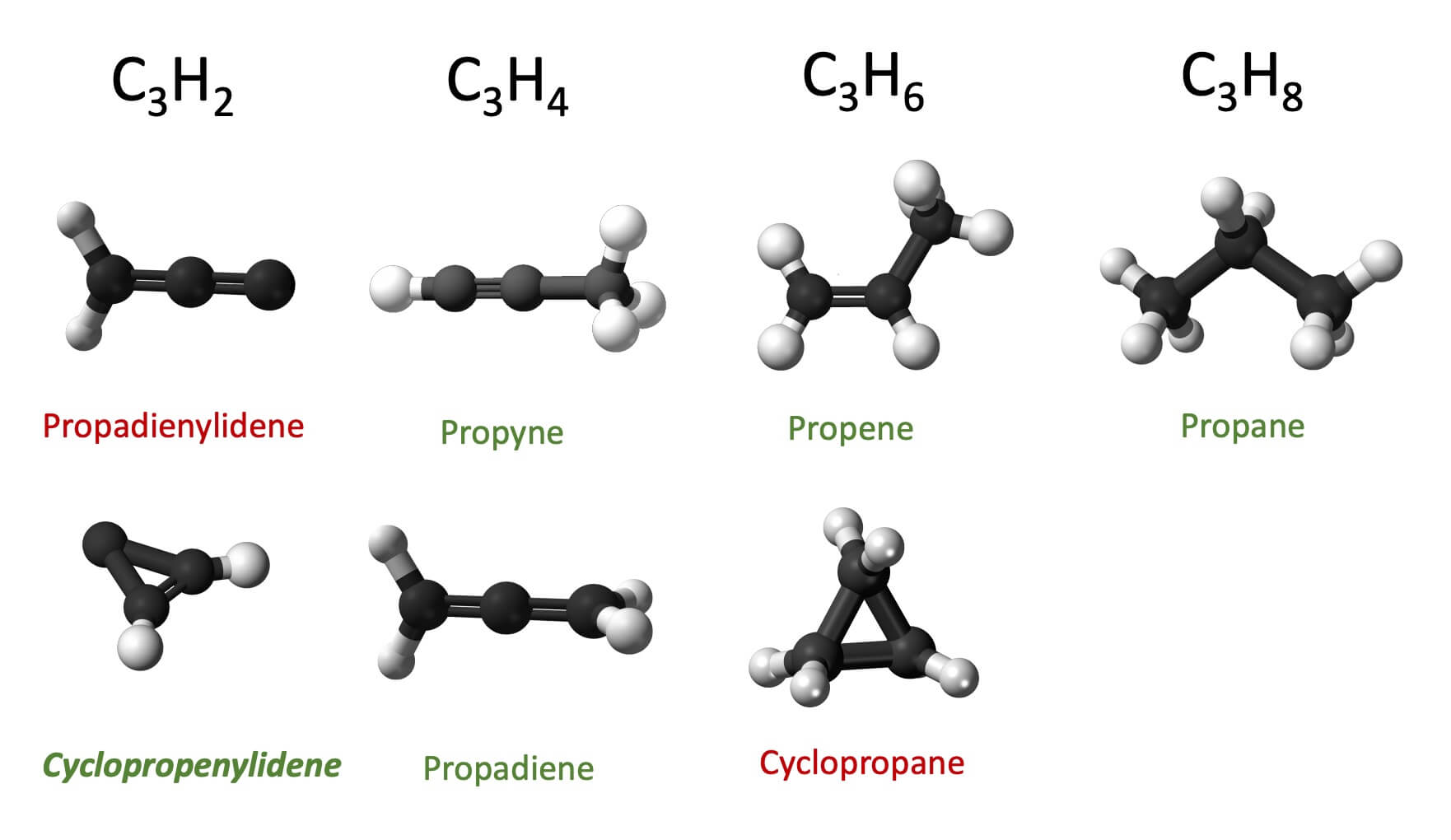Weird Molecule 'Cyclopropenylidene (C3H2)' Found on the Atmosphere of Saturn’s Moon - Titan And No One Knows How

Image © Conor Nixon/NASA's Goddard Space Flight Center
Cyclopropenylidene is the only other closed-loop molecule besides benzene to have been detected at Titan. Closed-loop molecules are important because they form the backbone rings for the nucleobases of DNA, the complex chemical structure that carries the genetic code of life, and RNA, another critical compound for life’s functions.
Recently, astronomers using NASA’s SOFIA telescope have confirmed, for the first time, the water (H2O) deposit on the sunlit surface of the Moon. And again NASA scientists using a radio telescope observatory in northern Chile known as the Atacama Large Millimeter/submillimeter Array (ALMA) identified a molecule in Titan’s atmosphere that has never been detected in any other atmosphere. The newly discovered molecule is C3H2, called cyclopropenylidene and no wonder many chemists have probably barely heard of it or are aware of its existence.
Until now, cyclopropenylidene has been detected only in molecular clouds of gas and dust, such as the Taurus Molecular Cloud, which is a stellar nursery in the constellation Taurus more than 400 light-years away.
Titan is already a weird moon not only of Saturn but of our solar system. It is the largest moon among 82 moons of Saturn and is the second-largest natural satellite in our Solar System. Titan is considered weird for many reasons; it is the only moon known to have a dense atmosphere, and the only known body in space, other than Earth, where clear evidence of stable bodies of surface liquid has been found. And now its weirdness added again!
Also Read: Universe’s First Type of Molecule Spotted
In addition, the dense atmosphere of the Titan are hives of chemical activity and this made a reason scientists are interested in this moon. The team here was able to identify small amounts of C3H2 at Titan likely because they were looking in the upper layers of the moon’s atmosphere, where there are fewer other gases for C3H2 to interact with.
Other scientists and even the involved team members don’t yet know why and how cyclopropenylidene would show up in Titan’s atmosphere but no other atmosphere.
Conor Nixon, a planetary scientist at NASA’s Goddard Space Flight Center in Greenbelt, Maryland, and who led the ALMA search said, “Titan is unique in our solar system. It has proved to be a treasure trove of new molecules.”
The team believes that the new molecule (C3H2) is simply a carbon-based molecule and maybe a precursor to more complex compounds that could form or feed possible life on Titan.

Nixon said, “When I realized I was looking at cyclopropenylidene, my first thought was, ‘Well, this is really unexpected.”
They noticed C3H2, which is made of carbon and hydrogen while sifting through a spectrum of unique light signatures collected by the telescope; these revealed the chemical makeup of Titan’s atmosphere by the energy its molecules emitted or absorbed.
The molecule cyclopropenylidene (C3H2) was first noticeably discovered in the interstellar medium (ISM) in 1985 through extensive laboratory and theoretical analysis to unearth the origin of several prominent, but previously unidentified lines seen on radio astronomical spectra. After this detection, the molecule has been found to be ubiquitous in the galaxy. This molecule is also easily detectable (in ISM) due to its relatively large dipole caused by the unpaired electrons on the bivalent carbon atom.
Though scientists have found C3H2 in pockets throughout the galaxy, finding it in an atmosphere was a surprise. That’s because cyclopropenylidene can react easily with other molecules it comes into contact with and forms different species.
Various mechanisms have been proposed for the formation of C3H2 and it is not clear at present which mechanisms are the most important. In the 1985 detection of cyclopropenylidene in the ISM f Thaddeus et al. describe cyclopropenylidene was produced by dissociative electron recombination of the cyclopropenylium cation, C3H3+ :
C3H3+ + e− → C3H2 + H
In a paper published in 2019 Vuitton et al. describe C3H3+ to be produced from acetylene via many other possible ion-molecule reactions like
CH3+ + C2H2 → C3H3+ + H2
Several other explanations for the formation of cyclopropenylidene can be found.
NASA’s scientists were, for long, targeting the atmosphere of our solar system to search for present or past life in the solar system. Similar to our Earth’s atmosphere, Titan’s atmosphere is made mostly of nitrogen and with a hint of methane.
When methane and nitrogen molecules break apart under the glare of the Sun, their component atoms unleash a complex web of organic chemistry that has captivated scientists and thrust this moon to the top of the list of the most important targets in NASA’s search for present or past life in the solar system.
About the habitability of the Titan, Rosaly Lopes, a senior research scientist and Titan expert at NASA’s Jet Propulsion Laboratory (JPL) in Pasadena, California said, “We’re trying to figure out if Titan is habitable. So we want to know what compounds from the atmosphere get to the surface, and then, whether that material can get through the ice crust to the ocean below because we think the ocean is where the habitable conditions are.”
Early in its history, 3.8 to 2.5 billion years ago, when methane filled Earth’s air instead of oxygen, conditions here could have been similar to those on Titan today, scientists suspect.
This finding also unblocked a new regime; they believe that this type of molecule might be sitting on Titan’s surface could be the same ones that formed the building blocks of life on Earth and so could help us in exploring the early universe.
Melissa Trainer, a NASA Goddard astrobiologist said, “We think of Titan as a real-life laboratory where we can see similar chemistry to that of ancient Earth when life was taking hold here.”
Nixon's team used the ALMA observatory to peer at Titan in 2016. They were surprised to find a strange chemical fingerprint, which Nixon identified as cyclopropenylidene by searching through a database of all known molecular light signatures and to double-cross the finding they pored through research papers published from analyses of data from NASA’s Cassini spacecraft, which made 127 close flybys of Titan between 2004 and 2017; they were true in their findings.
Given that it’s a rare find, scientists are trying to learn more about cyclopropenylidene and how it might interact with gases in Titan’s atmosphere. For this and to advance our search for the building blocks of life NASA is developing a mission that delivers a rotorcraft to Saturn’s moon Titan. While Dragonfly was originally scheduled to launch in 2026, NASA has requested the Dragonfly team pursue their alternative launch readiness date in 2027.
A research paper about the finding was published in the journal Astronomical Journal.
